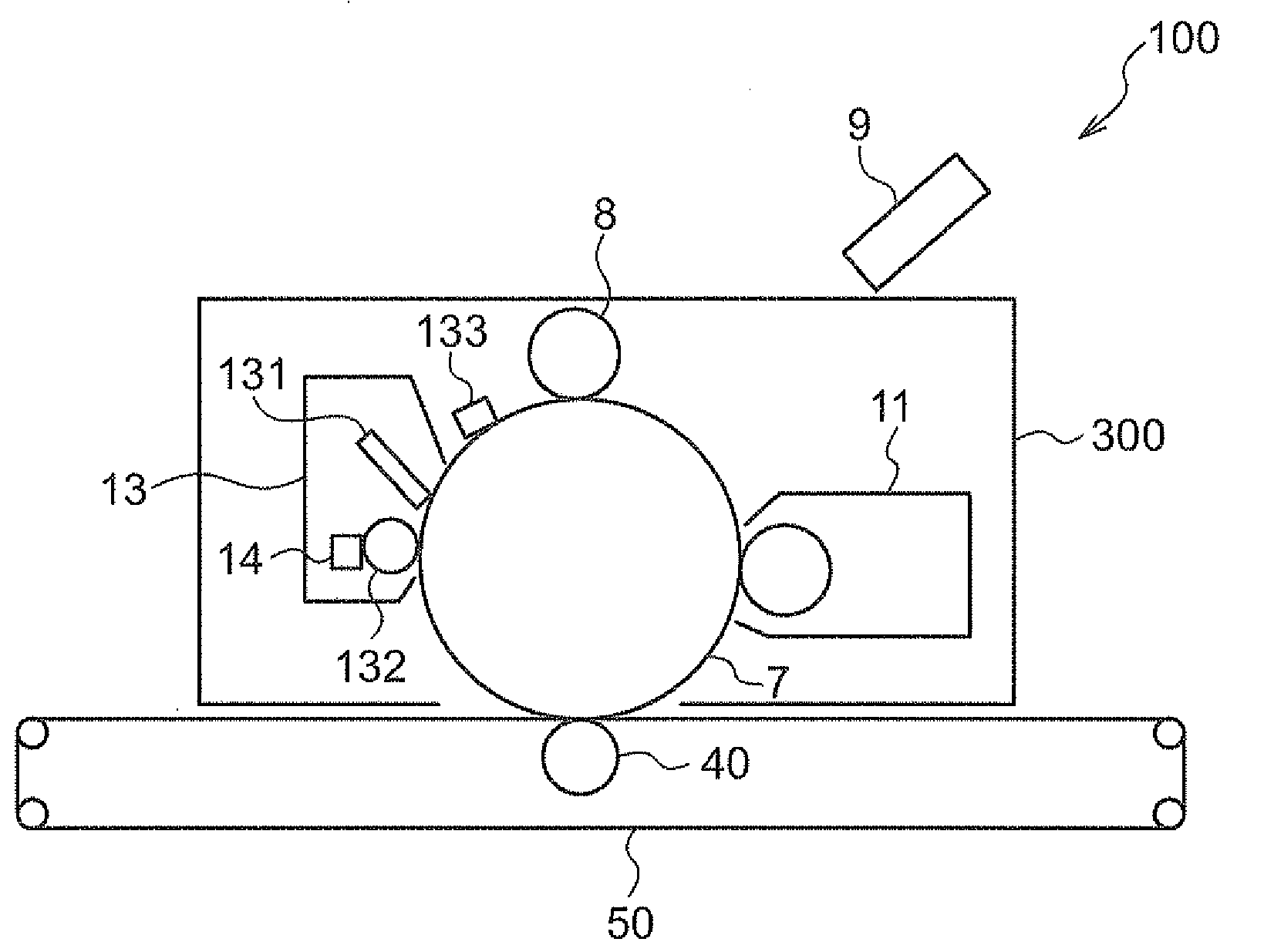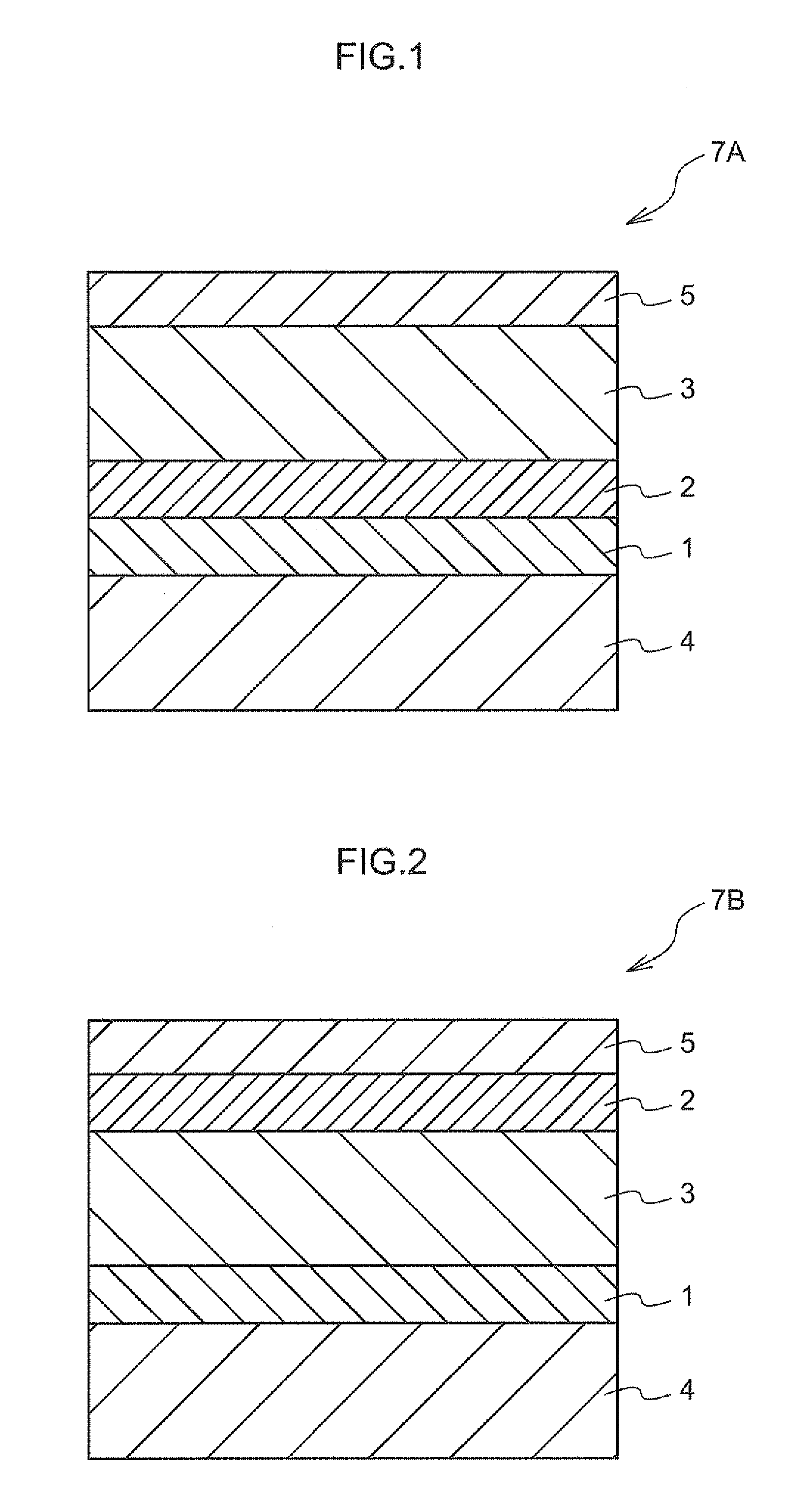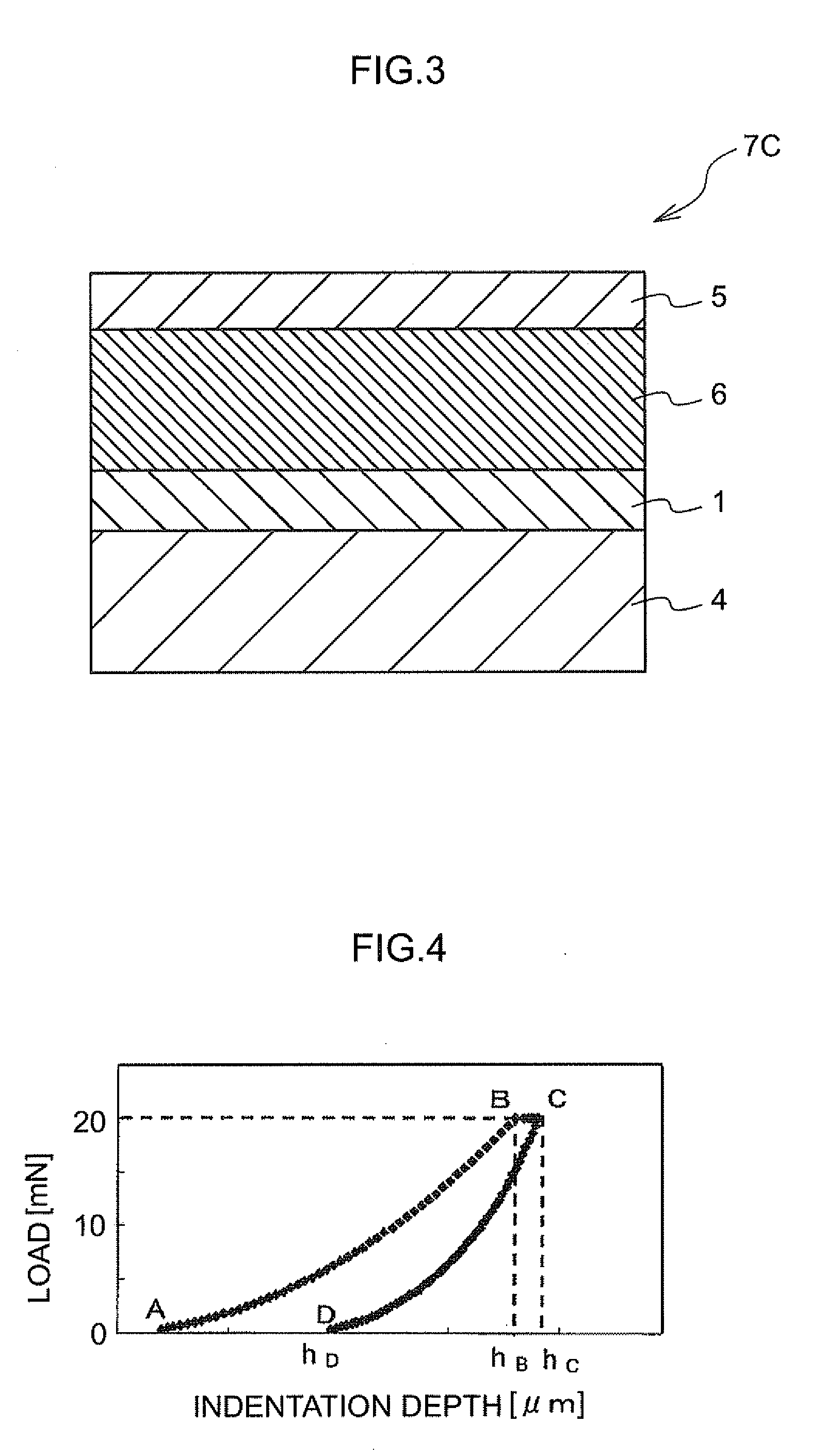[0125]The
alcohol-soluble resin here refers to a resin that dissolves in an
alcohol having 5 or less carbon atoms, in an amount of 1% or less by weight of the resin. Examples of the
alcohol-soluble resin include a
polyvinyl butyral resin, a polyvinyl formal resin, a partially-acetalized polyvinyl
acetal resin, including those obtained by modifying part of butyral with formal or
acetal (for example, S-LEC B and S-LEC K (
trade name, manufactured by Sekisui Chemical Co., Ltd.), a
polyimide resin, a
cellulose resin, and a polyvinyl
phenol resin. From the viewpoint of electrical property, a polyvinyl
acetal resins and a polyvinyl
phenol resin are particularly preferred. The weight-average molecular weight of the alcohol-soluble resin is preferably from 2,000 to 100,000, more preferably from 5,000 to 50,000. If the molecular weight of the resin is less than 2,000, the advantageous effects achieved by the addition of the resin may not be sufficient. If the molecular weight is more than 100,000, the
solubility may decrease and the possible addition amount may be limited, and further defective film formation may occur during the application of the composition. The addition amount of the resin is preferably from 1% by weight to 40% by weight, more preferably from 1% by weight to 30% by weight, and even more preferably from 5% by weight to 20% by weight. If the addition amount of the resin is less than 1% by weight, advantageous effects achieved by the addition of the resin may not be sufficient. If the amount is more than 40% by weight, obscure images tend to be formed at high temperature and
high humidity (for example, at 28° C. and 85% RH).
[0126]It is preferred to add an
antioxidant to the surface
protection layer 5 to prevent a deterioration thereof by effect of an oxidizing gas generated in the charging unit, such as
ozone. As the
mechanical strength of the surface of the electrophotographic photoreceptor is increased and the lifespan thereof is extended, the electrophotographic photoreceptor contacts an oxidizing gas for a longer time. Therefore, the electrophotographic photoreceptor needs to have an anti-oxidation property that is higher than that of prior art. The
antioxidant is preferably a
hindered phenol or a hindered amine
antioxidant. Other applicable known antioxidants include organic
sulfur antioxidants, phosphite antioxidants,
dithiocarbamate antioxidants,
thiourea antioxidants, and
benzimidazole antioxidants. The addition amount of the antioxidant is preferably 20% by weight or less, more preferably 10% by weight or less.
[0127]Examples of the
hindered phenol antioxidant include 2,6-di-t-butyl-4-methylphenol, 2,5-di-t-butylhydroquinone, N,N′-hexamethylenebis(3,5-di-t-butyl-4-hydroxyhydrocinnamide), diethyl-3,5-di-t-butyl-4-hydroxy-benzylphosphate, 2,4-bis[(octylthio)methyl]-o-
cresol, 2,6-di-t-butyl-4-ethylphenol, 2,2′-methylenebis(4-methyl-6-t-butylphenol), 2,2′-methylenebis(4-ethyl-6-t-butylphenol), 4,4′-butylidenebis(3-methyl-6-t-butylphenol), 2,5-di-t-amylhydroquinone, 2-t-butyl-6-(3-butyl-2-hydroxy-5-methylbenzyl)-4-methylphenyl
acrylate, and 4,4′-butylidenebis(3-methyl-6-t-butylphenol).
[0128]Examples of commercially available products of the
hindered phenol antioxidant include IRGANOX 1076, IRGANOX 1010, IRGANOX 1098, IRGANOX 245, IRGANOX 1330, IRGANOX 3114, IRGANOX 1076 (
trade name, manufactured by Ciba Japan, K.K.), and 3,5-di-t-butyl-4-hydroxybiphenyl.
[0129]Examples of commercially available products of the hindered amine antioxidant include SANOL LS2626, SANOL LS765, SANOL LS770, SANOL LS744 (
trade name, manufactured by Ciba Japan, K.K.), TINUVIN 144, TINUVIN 622LD (trade name, manufactured by Ciba Japan, K.K.), MARK LA57, MARK LA67, MARK LA62, MARK LA68, and MARK LA63 (trade name, manufactured by Adeka Corporation). Examples of commercially available products of the
thioether antioxidant include SUMILIZER TPS and SUMILIZER TP-D (trade name, manufactured by Sumitomo Chemical Co., Ltd.). Examples of commercially available products of the phosphite antioxidants include MARK 2112, MARK PEP-8, MARK PEP-24G, MARK PEP-36, MARK 329K, and MARK HP-10 (trade name, manufactured by Adeka Corporation).
[0130]The surface protection layer 5 may include particles of various kinds for the purpose of lowering the residual potential or improving the strength thereof. One examples of such particles is
silicon-containing particles. The
silicon-containing particles are particles that contain
silicon as a constituting element thereof. Specific examples the silicon-containing particles include
colloidal silica and
silicone particles. The
colloidal silica used as the silicon-containing particles may be selected from those produced by dispersing silica having an average particle size of 1 nm to 100 nm, preferably 10 nm to 30 nm, in an acidic or alkaline
aqueous solution or an
organic solvent such as alcohol,
ketone or ester. Commercially available products may be used as the
colloidal silica. The
solid content concentration of the colloidal silica in the surface protection layer 5 is not particularly limited, and is from 0.1% by weight to 50% by weight, preferably from 0.1% by weight to 30% by weight, of the
total solid content in the surface protection layer 5, from the viewpoint of film-forming properties, electrical properties or strength.
 Login to View More
Login to View More 


